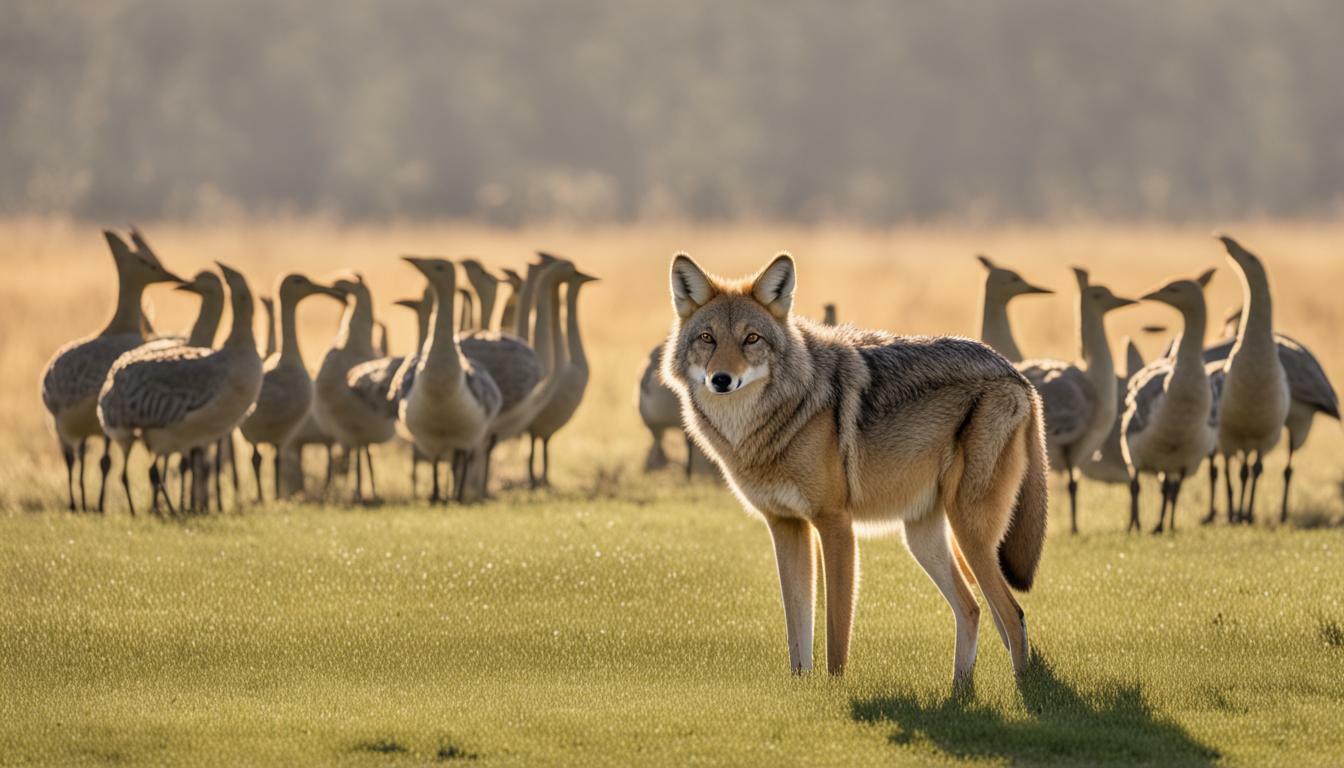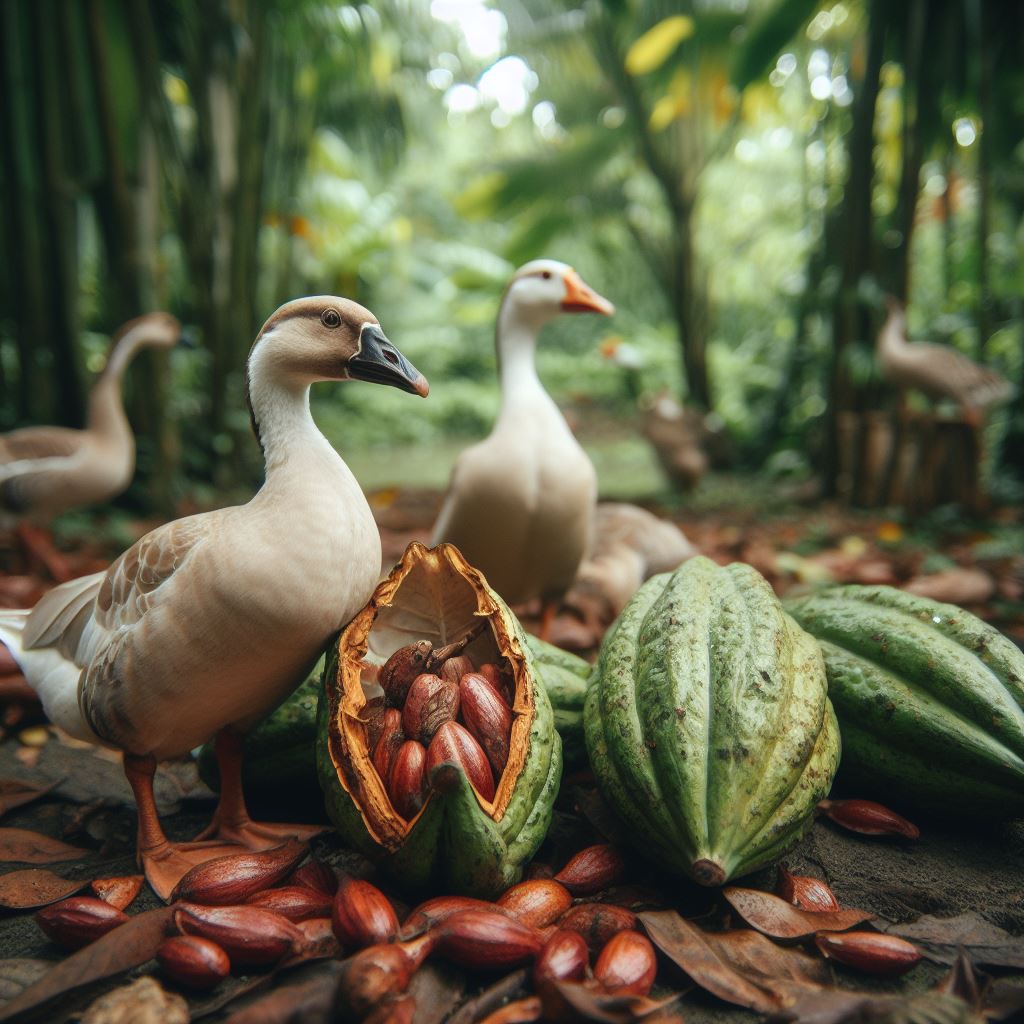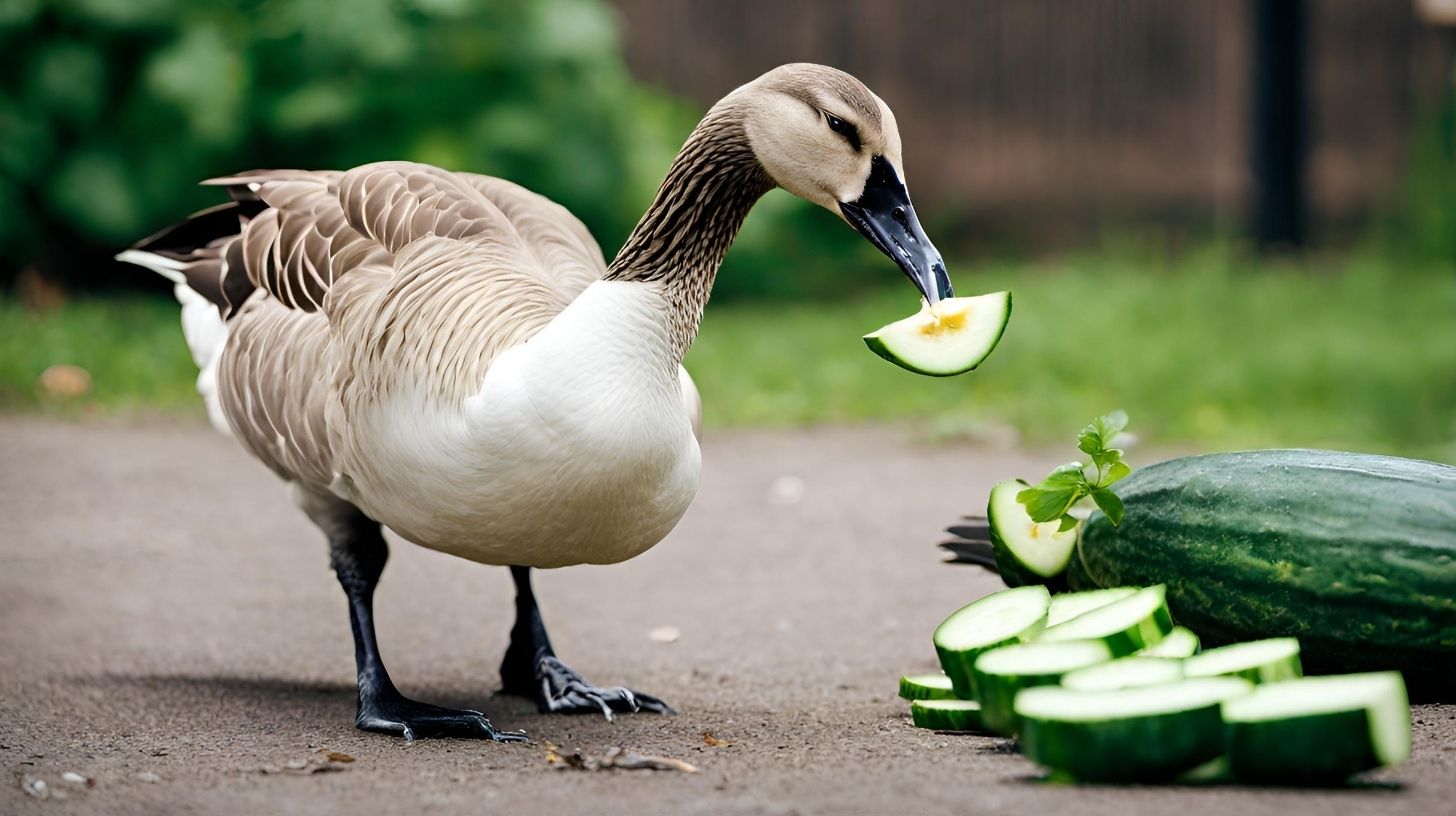Do Coyotes Eat Geese? Unveiling Coyote Diets

Table of content:
- Do Coyotes Hunt Geese?
- Do Coyotes Eat Goose Eggs?
- How Do Coyotes Hunt Adult Geese?
- How Do Geese Avoid Coyote Attacks?
- Times of Year When Geese Are Vulnerable to Coyotes
- Do Urban Coyotes Hunt Park Geese?
- How Common Is It for Coyotes to Prey on Geese?
- Other Goose Predators Coyotes Compete With
- Ways To Protect Geese From Coyote Attacks
- Are Some Geese More Vulnerable to Coyotes?
- Conclusion
Coyotes and geese often share the same habitats in parks, fields, and wetlands. As opportunistic predators, coyotes will eat geese if given the chance. However, geese have evolved defense mechanisms that allow them to coexist with coyotes in many areas.
Do Coyotes Hunt Geese?
As predators, coyotes are always looking for their next meal. Geese can provide coyotes with a high-protein food source. Coyotes will target geese eggs, goslings, juveniles, injured geese, molting geese, and even adult geese depending on the circumstances.
Coyotes employ various hunting strategies when targeting geese:
- Stalking – Coyotes will stealthily approach resting or feeding geese from downwind before rushing to grab one. They rely on surprise and speed.
- Group hunting – Packs of coyotes can coordinate to cut off and isolate individual geese from the safety of a gaggle. This enables them to take down larger prey.
- Digging – Coyotes will dig up buried goose eggs and grab goslings from ground nests.
- Standing water ambush – Coyotes will lie in wait in shallow water to ambush swimming geese or newly hatched goslings.
Do Coyotes Eat Goose Eggs?
Goose eggs provide coyotes with a high-calorie, high-protein meal. Coyotes will seek out ground nests built by Canada geese and dig up the eggs. The coyote will carry the egg away in its mouth before piercing the shell with its teeth.
Goose eggs have a thick shell, so the coyote needs to work to crack it open. Once inside, they lap up the rich yolk and egg whites. A single Canada goose egg can provide a coyote with roughly 90 calories of energy.
Nesting geese try to avoid areas frequented by coyotes when choosing nest sites. However, coyotes still manage to dig up many unprotected goose eggs each spring.
How Do Coyotes Hunt Adult Geese?
Adult geese can be difficult prey for coyotes to successfully hunt. Geese have many natural defenses that aid their survival:
- Flocking behavior – Geese find safety in numbers in large flocks. Attacking single geese is risky with many others nearby to fight back.
- Vigilance – Geese keep a constant lookout for threats while feeding and resting. It is hard for coyotes to surprise them.
- Alert calls – Geese loudly honk if a predator is spotted alerting the entire flock to danger.
- Powerful beaks – Geese have tough, serrated beaks that can deliver painful bites if captured.
- Strong wings – Geese vigorously beat their large wings when attacked making them difficult to hold onto.
To overcome these defenses, coyotes must catch the geese off guard and outmaneuver them. Coyotes may rush from concealed positions to isolate a goose from the flock. If the goose takes flight, coyotes may grab and bitewings or feet rather than the more dangerous beak.
Injured, sick, or molting geese are easier targets for coyotes. These birds cannot fly away or fight back as effectively. Some urban coyotes have even learned to hunt park geese at night while they roost. Overall, successfully hunting healthy adult geese still remains challenging for coyotes.
How Do Geese Avoid Coyote Attacks?
Geese have coexisted with coyotes for long enough to develop effective defenses. Here are some of the main tactics geese use to avoid becoming prey:
- Flocking – Geese stick together in large flocks which provides safety in numbers. Being solitary or in a small group is very risky.
- Vigilance – Geese constantly keep watch for coyotes and other predators while feeding and resting. This allows them to take flight before an attack.
- Aggressive defense – Geese are very territorial and will aggressively chase foxes, dogs, and other threats from nesting areas. They may deter coyotes.
- Alarm calls – Loud honking alerts the entire flock to danger. This ruins any chance of a surprise coyote attack.
- Nest site selection – Geese try to build nests on islands or over water that coyotes can’t easily access. However, some eggs still get stolen from shoreline nests.
- Short molting period – Geese lose their flight feathers simultaneously and regrow them quickly to avoid extended time on the ground.
- Migration – Some goose species migrate away from areas with high coyote populations during nesting season.
- Parental defense – Goose parents are very protective and will fight bitterly to defend eggs, goslings, and even juveniles from coyotes.
Through these adaptations, geese manage to limit their losses to coyotes. But coyotes still regularly prey on the more vulnerable individuals in the goose population.
Times of Year When Geese Are Vulnerable to Coyotes
Geese face higher risks of coyote attacks during certain times of the year:
Spring – Nesting Season
- Nesting geese are focused on breeding and egg laying from March to May.
- They are very territorial and aggressive during this period.
- Coyotes still manage to dig up some buried eggs. Goslings are also vulnerable when leaving the nest.
Late Spring – Molting Season
- Adult geese are unable to fly for 4-6 weeks in late spring when growing new flight feathers.
- They are mostly restricted to waterways to avoid predators during this time.
- Groups of coyotes can successfully attack flightless geese on land.
Summer – Rearing Season
- Goslings and juvenile geese are vulnerable to coyotes in summer.
- Parents are very protective but coyotes may still snatch goslings from the shoreline.
- Juveniles begin learning to fly around 2-3 months but are still naive and weak fliers.
Winter – Lean Times
- Food is scarce for both coyotes and geese in winter.
- Hungry coyotes may take more risks attacking vigilant geese to survive.
- Large flocks of geese can overwhelm single coyotes though.
So geese must be most vigilant during nesting, molting, and rearing seasons when coyotes pose the greatest threat.
Do Urban Coyotes Hunt Park Geese?
In urban areas, many parks provide habitat for both coyotes and geese. Well-fed urban coyotes are often bold enough to hunt park geese despite high human activity.
Urban coyotes have learned that parks provide:
- Plentiful goose eggs and goslings in spring.
- Ponds and open lawns to better spot and chase geese.
- Hiding places to launch ambush attacks.
- Readily available food waste to supplement their diet.
- Minimal competition from larger predators like wolves or bears.
Well-fed urban coyotes can focus more energy on catching geese. While park geese are often comfortable around humans, they still can perceive attacking coyotes as a threat.
To better coexist, municipalities may need to alter habitats in parks to minimize conflicts between geese and coyotes. Removing hiding cover near ponds and reinforcing nests can help reduce losses. Providing alternative food sources for coyotes can also decrease their reliance on hunting geese.
How Common Is It for Coyotes to Prey on Geese?
Research shows geese are frequent but not primary prey for coyotes. Here are some statistics on how commonly they target geese:
- Studies of urban coyote scat in Chicago showed geese appeared in 23% of samples. But most of their diet consisted of small rodents.
- Analyses of coyote stomach contents in Nebraska found geese and ducks in 21-26% of samples. Rabbits were the main prey.
- A Nova Scotia study found coyotes killed an average of 8 geese and 4 ducks per square kilometer annually.
- Research on Newfoundland coyotes showed that 3-7% of scat samples contained goose remains. They relied more on moose carcasses.
So while not a staple food source, geese do provide staple supplemental nutrition for coyotes in many regions. Their predation can significantly reduce gosling survival rates in some locations.
Other Goose Predators Coyotes Compete With
Coyotes are far from the only predators geese must watch out for. They compete with other predators that also prey on eggs and adults.
Foxes
Red foxes and gray foxes also consume goose eggs, goslings, and sometimes adults. Foxes are stealthy predators but they lack the pack-hunting ability of coyotes. Foxes are also prey for coyotes so they avoid direct competition when possible.
Raccoons
These masked bandits raid bird nests at night for eggs and goslings. Raccoons occasionally catch an injured adult goose but they are not effective open-field hunters. Raccoons focus more on stealing eggs than coyotes do.
Feral/Loose Dogs
Some dog breeds still retain hunting instincts and will chase, attack, and kill geese. Packs of loose dogs can be especially dangerous predators. Animal control programs that limit free-roaming dogs help reduce this threat to geese.
Hawks
Large predatory hawks like bald eagles can catch adult geese on the wing or snatch goslings from the water’s edge. However, hawks generally pose little threat to large flocks of geese.
Humans
In hunting season, licensed waterfowl hunters take considerable numbers of geese legally. Poachers also illegally kill some geese outside hunting seasons. Habitat loss from human development also reduces available nesting sites and food resources for geese.
So coyotes are certainly not the only threat facing goose flocks. Their effects on goose populations depend on the geese’s coexisting predator community.
Ways To Protect Geese From Coyote Attacks
If you wish to protect geese on your property from coyote attacks, some effective precautions include:
- Eliminate hiding cover and improve visibility near ponds so geese can better detect stalking coyotes.
- Install predator-proof fencing or cages around nesting sites to prevent egg theft.
- Use flashing lights, sound devices, or scarecrows to frighten off coyotes from approaching nesting areas.
- Keep dogs confined or leashed when walking near geese to prevent disturbing the flock.
- Clear away brush beneath bird feeders where coyotes may lurk to ambush feeding geese.
- Support hunting regulations that maintain balanced coyote, fox, and geese populations.
- Avoid unintentionally feeding coyotes or having exposed trash that attracts them to parks and geese.
With some sensible precautions, we can help minimize unnecessary conflicts between geese and the opportunistic coyotes living among them.
Are Some Geese More Vulnerable to Coyotes?
Not all geese face the same level of risk from potential coyote attacks. Here are some key factors that increase vulnerability:
- Size – Larger goose species can better fend off coyotes. Smaller species are more easily overpowered.
- Habitat – Ground-nesting or Arctic-nesting geese are more prone to egg loss from coyotes than tree or cliff nesters.
- Tameness – Geese accustomed to humans often lose wariness toward canine predators compared to wild geese.
- Nesting location – Geese nesting near coyote dens or known hunting grounds are more exposed to predation.
- Sickness/injury – Geese unable to keep up with their flock have higher predation risks.
- Molting group size – Lone molting geese or tiny flocks are vulnerable compared to larger molt groups.
- Parental attentiveness – Geese who leave eggs and goslings unattended put them at greater risk.
- Human presence – Geese in parks with few visitors may receive less protection from coyotes than busier parks.
To summarize, smaller, tamer, sick/injured geese isolated from their flock and humans are the most likely targets for hungry coyotes. Healthy adults in large flocks have the best chances of avoiding predation.
Conclusion
Coyotes are opportunistic predators that will eat geese and their eggs when accessible. However, geese have adapted effective defenses over time to limit losses to coyotes. Avoiding situations where coyotes can isolate individuals from the flock is the best way for geese to minimize risks. With thoughtful management, we can promote sustainable coexistence between geese populations and the coyotes that live among them.
Welcome. I’m Adreena Shanum, the proud owner of this website, and I am incredibly passionate about animals, especially poultry. I founded adreenapets.com as a labor of love, stemming from my desire to share my knowledge and experiences with poultry enthusiasts worldwide.




